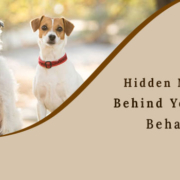Hidden Meaning Behind Your Dog’s Actions
No matter whether we spend more or less time with the dogs until we do not make the healthy conversation with the bitty tail-rocking pal. If you do not try to contact them, that day isn’t coming anytime soon. For now, we’ll have to learn to read the facts on dogs, such as the non-verbal meaning of connection.
The emotional quotient of the dog is represented to be comparable to that of a newborn. It’s no surprise that dogs cannot express emotions the same way as adults do, by speaking by mouth. But they’re also incapable of holding complicated feelings such as shame, pride, and remorse. This article tells you about the hidden meanings behind their actions. So if you gain the same information, let’s first try understanding how dogs talk.
Positive Body Language
Dogs pick up on their master’s body language almost. This is how they determine between aggression and play. Dogs can detect unknown impressions from the human body language and thus react accordingly. Essentially, the higher the tail, the more assertive the dog. Dogs with their tails pointing down to the ground or even tucked between their legs are feeling fear and stress. Dogs with their tails held up like a flag are feeling confident, perhaps even aggressive.
Tilting
When a dog is unsurely about something he’s truly involved in, he tilts his head. It’s almost as; however, they sometimes understand what you’re saying. Dogs can read and respond exceptionally well to your body language and speech cues.
Direct eye contact
It’s all about making eye contact. On one side, eye contact can make a dominant dog feel challenged, while on the other hand, it can terrify a comfortable dog. Dogs can even determine between different types of stares. Research also suggests that dogs’ eyes can reflect whether they are contented or are feeling threatened and stressed.
Facial Expressions
Dogs rely slowly on facial expressions and movements to make content. Dogs can find out emotions and analyses facial expressions.
Standing up on their hind legs
A dog standing on its hind legs can send a variety of messages. They may want to accept you or specify that they are playing with other dogs. When you and your dog are alone, looking after up might be a show of affection – they may truly want to reach out and hug you.
Bringing you toys
Dogs enjoy fetch, but just because they bring one of their favorite toys to you doesn’t guarantee they want to play. They may be indicating their trust in you, or they may endeavor to satisfy you. Remember that throwing the ball when your dog is merely endeavoring to show it to you could deeply hurt their feelings.
Chewing
If your dog is still a puppy, then they are, in all probability, trying to relieve the pain of its adult teeth. However, if they are not, it suggests they are not receiving enough exercise and aren’t sure how else to release their energy. Taking them for a walk might not be sufficient to fix all of your problems, but it’s a start. When your dog is not getting enough exercise, it’s commonly obvious, and this is one of the most obvious indicators. Still, encouraging them to be more active should be your top focus, If your canine is trashing your furniture.
Yawning
While yawning around individuals, a dog can signify that they are in comfort, endless yawning in public (or in situations where a dog is not relaxed) can signify something quite different.
Wiggling
When a dog wriggles, it will kick all its legs up in the air and creep around on its back. For the most part, this movement is as enjoyable to a dog as you might imagine. If your dog arrives to be wiggling excessively or concentrating all of its movements on one body part, it could be trying to reach an itch or another irritation. In some circumstances, it may be seeking to attract your attention. Why do you not join them at the bottom and play with them for many minutes?


